Reflective Journal: Applying Kinesics to a Communication Incident
VerifiedAdded on 2023/06/13
|6
|1385
|329
Journal and Reflective Writing
AI Summary
This reflective journal entry analyzes a communication incident between the author and their brother, focusing on the non-verbal communication concept of kinesics. The incident involves a request to take out the trash, met with non-verbal resistance from the brother. The journal explains kinesics, detailing regulators, emblems, illustrators, and affective displays. It then links the concept to the incident, illustrating how the brother's facial expressions, head movements, and body language conveyed his unwillingness and annoyance. The author concludes that non-verbal communication is crucial, especially in expressing emotions, and that kinesics effectively interprets the brother's non-verbal cues during the incident. Desklib offers a variety of resources including similar assignments and study tools for students.
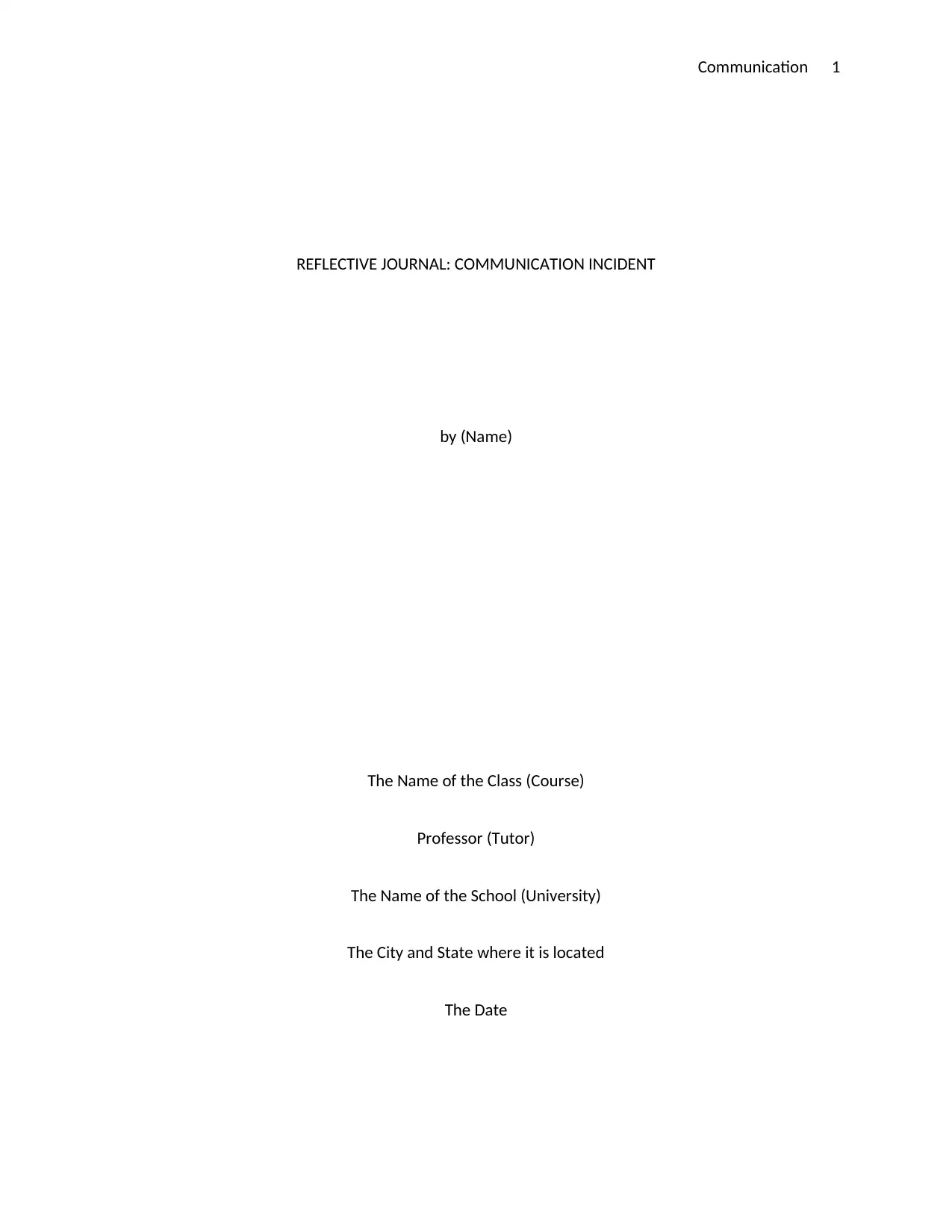
Communication 1
REFLECTIVE JOURNAL: COMMUNICATION INCIDENT
by (Name)
The Name of the Class (Course)
Professor (Tutor)
The Name of the School (University)
The City and State where it is located
The Date
REFLECTIVE JOURNAL: COMMUNICATION INCIDENT
by (Name)
The Name of the Class (Course)
Professor (Tutor)
The Name of the School (University)
The City and State where it is located
The Date
Paraphrase This Document
Need a fresh take? Get an instant paraphrase of this document with our AI Paraphraser
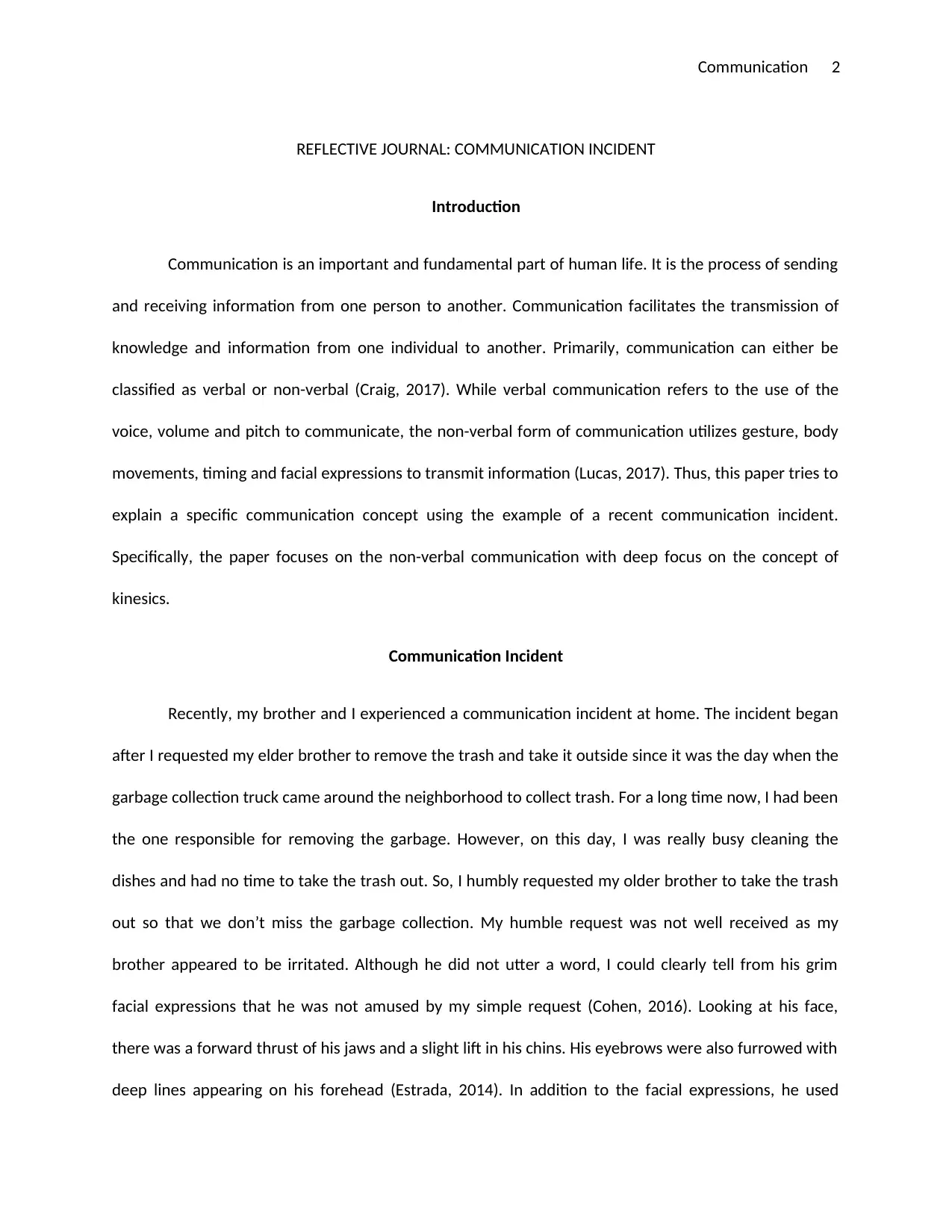
Communication 2
REFLECTIVE JOURNAL: COMMUNICATION INCIDENT
Introduction
Communication is an important and fundamental part of human life. It is the process of sending
and receiving information from one person to another. Communication facilitates the transmission of
knowledge and information from one individual to another. Primarily, communication can either be
classified as verbal or non-verbal (Craig, 2017). While verbal communication refers to the use of the
voice, volume and pitch to communicate, the non-verbal form of communication utilizes gesture, body
movements, timing and facial expressions to transmit information (Lucas, 2017). Thus, this paper tries to
explain a specific communication concept using the example of a recent communication incident.
Specifically, the paper focuses on the non-verbal communication with deep focus on the concept of
kinesics.
Communication Incident
Recently, my brother and I experienced a communication incident at home. The incident began
after I requested my elder brother to remove the trash and take it outside since it was the day when the
garbage collection truck came around the neighborhood to collect trash. For a long time now, I had been
the one responsible for removing the garbage. However, on this day, I was really busy cleaning the
dishes and had no time to take the trash out. So, I humbly requested my older brother to take the trash
out so that we don’t miss the garbage collection. My humble request was not well received as my
brother appeared to be irritated. Although he did not utter a word, I could clearly tell from his grim
facial expressions that he was not amused by my simple request (Cohen, 2016). Looking at his face,
there was a forward thrust of his jaws and a slight lift in his chins. His eyebrows were also furrowed with
deep lines appearing on his forehead (Estrada, 2014). In addition to the facial expressions, he used
REFLECTIVE JOURNAL: COMMUNICATION INCIDENT
Introduction
Communication is an important and fundamental part of human life. It is the process of sending
and receiving information from one person to another. Communication facilitates the transmission of
knowledge and information from one individual to another. Primarily, communication can either be
classified as verbal or non-verbal (Craig, 2017). While verbal communication refers to the use of the
voice, volume and pitch to communicate, the non-verbal form of communication utilizes gesture, body
movements, timing and facial expressions to transmit information (Lucas, 2017). Thus, this paper tries to
explain a specific communication concept using the example of a recent communication incident.
Specifically, the paper focuses on the non-verbal communication with deep focus on the concept of
kinesics.
Communication Incident
Recently, my brother and I experienced a communication incident at home. The incident began
after I requested my elder brother to remove the trash and take it outside since it was the day when the
garbage collection truck came around the neighborhood to collect trash. For a long time now, I had been
the one responsible for removing the garbage. However, on this day, I was really busy cleaning the
dishes and had no time to take the trash out. So, I humbly requested my older brother to take the trash
out so that we don’t miss the garbage collection. My humble request was not well received as my
brother appeared to be irritated. Although he did not utter a word, I could clearly tell from his grim
facial expressions that he was not amused by my simple request (Cohen, 2016). Looking at his face,
there was a forward thrust of his jaws and a slight lift in his chins. His eyebrows were also furrowed with
deep lines appearing on his forehead (Estrada, 2014). In addition to the facial expressions, he used
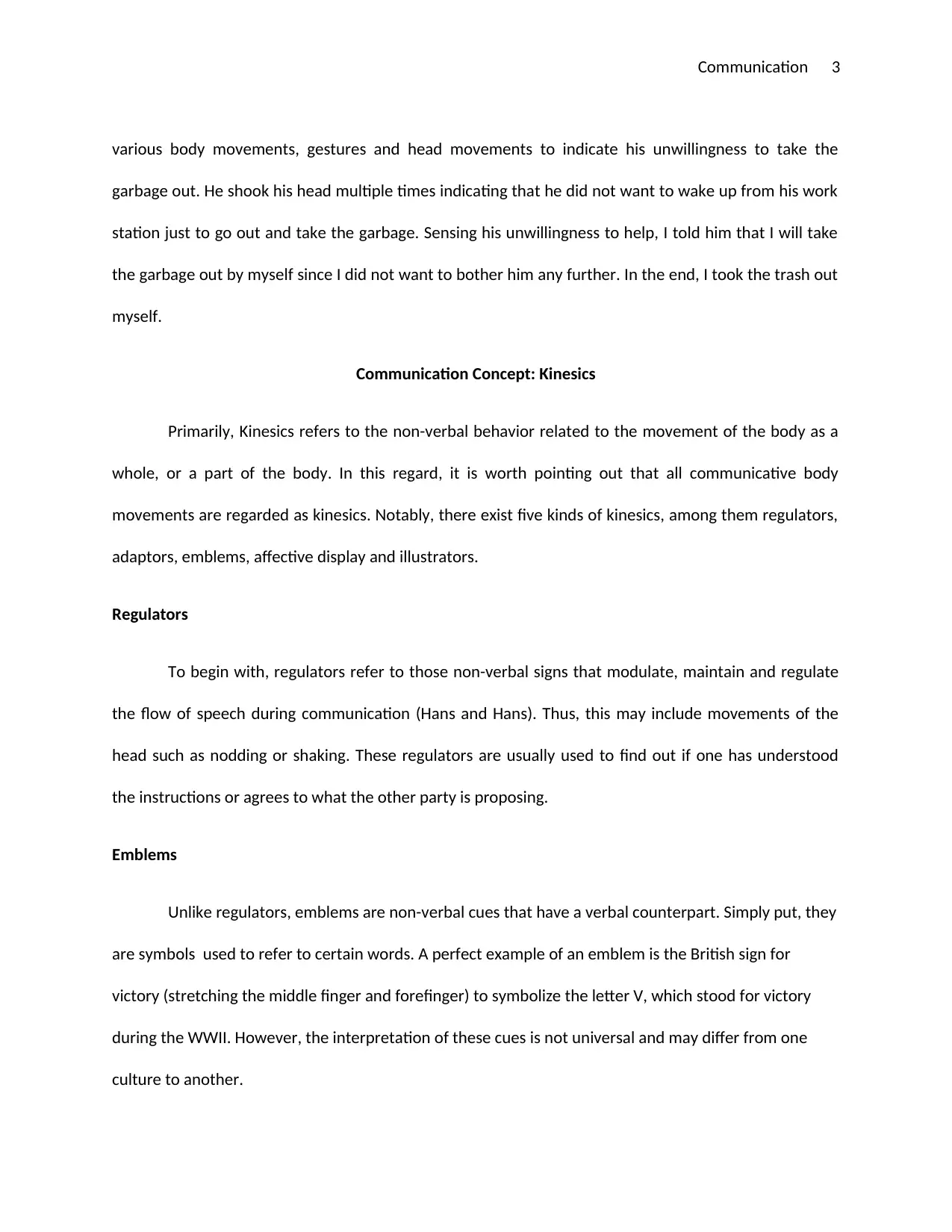
Communication 3
various body movements, gestures and head movements to indicate his unwillingness to take the
garbage out. He shook his head multiple times indicating that he did not want to wake up from his work
station just to go out and take the garbage. Sensing his unwillingness to help, I told him that I will take
the garbage out by myself since I did not want to bother him any further. In the end, I took the trash out
myself.
Communication Concept: Kinesics
Primarily, Kinesics refers to the non-verbal behavior related to the movement of the body as a
whole, or a part of the body. In this regard, it is worth pointing out that all communicative body
movements are regarded as kinesics. Notably, there exist five kinds of kinesics, among them regulators,
adaptors, emblems, affective display and illustrators.
Regulators
To begin with, regulators refer to those non-verbal signs that modulate, maintain and regulate
the flow of speech during communication (Hans and Hans). Thus, this may include movements of the
head such as nodding or shaking. These regulators are usually used to find out if one has understood
the instructions or agrees to what the other party is proposing.
Emblems
Unlike regulators, emblems are non-verbal cues that have a verbal counterpart. Simply put, they
are symbols used to refer to certain words. A perfect example of an emblem is the British sign for
victory (stretching the middle finger and forefinger) to symbolize the letter V, which stood for victory
during the WWII. However, the interpretation of these cues is not universal and may differ from one
culture to another.
various body movements, gestures and head movements to indicate his unwillingness to take the
garbage out. He shook his head multiple times indicating that he did not want to wake up from his work
station just to go out and take the garbage. Sensing his unwillingness to help, I told him that I will take
the garbage out by myself since I did not want to bother him any further. In the end, I took the trash out
myself.
Communication Concept: Kinesics
Primarily, Kinesics refers to the non-verbal behavior related to the movement of the body as a
whole, or a part of the body. In this regard, it is worth pointing out that all communicative body
movements are regarded as kinesics. Notably, there exist five kinds of kinesics, among them regulators,
adaptors, emblems, affective display and illustrators.
Regulators
To begin with, regulators refer to those non-verbal signs that modulate, maintain and regulate
the flow of speech during communication (Hans and Hans). Thus, this may include movements of the
head such as nodding or shaking. These regulators are usually used to find out if one has understood
the instructions or agrees to what the other party is proposing.
Emblems
Unlike regulators, emblems are non-verbal cues that have a verbal counterpart. Simply put, they
are symbols used to refer to certain words. A perfect example of an emblem is the British sign for
victory (stretching the middle finger and forefinger) to symbolize the letter V, which stood for victory
during the WWII. However, the interpretation of these cues is not universal and may differ from one
culture to another.
⊘ This is a preview!⊘
Do you want full access?
Subscribe today to unlock all pages.

Trusted by 1+ million students worldwide
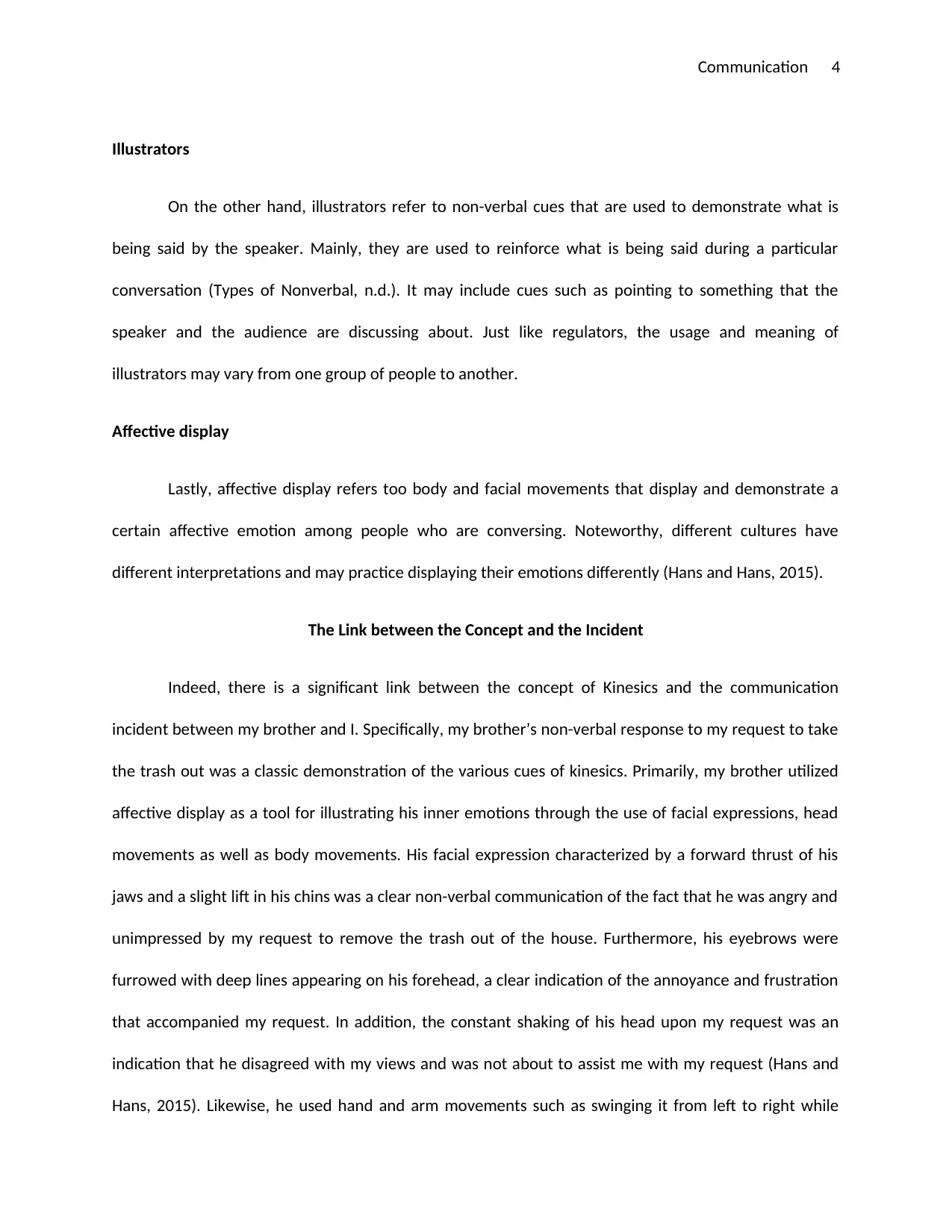
Communication 4
Illustrators
On the other hand, illustrators refer to non-verbal cues that are used to demonstrate what is
being said by the speaker. Mainly, they are used to reinforce what is being said during a particular
conversation (Types of Nonverbal, n.d.). It may include cues such as pointing to something that the
speaker and the audience are discussing about. Just like regulators, the usage and meaning of
illustrators may vary from one group of people to another.
Affective display
Lastly, affective display refers too body and facial movements that display and demonstrate a
certain affective emotion among people who are conversing. Noteworthy, different cultures have
different interpretations and may practice displaying their emotions differently (Hans and Hans, 2015).
The Link between the Concept and the Incident
Indeed, there is a significant link between the concept of Kinesics and the communication
incident between my brother and I. Specifically, my brother’s non-verbal response to my request to take
the trash out was a classic demonstration of the various cues of kinesics. Primarily, my brother utilized
affective display as a tool for illustrating his inner emotions through the use of facial expressions, head
movements as well as body movements. His facial expression characterized by a forward thrust of his
jaws and a slight lift in his chins was a clear non-verbal communication of the fact that he was angry and
unimpressed by my request to remove the trash out of the house. Furthermore, his eyebrows were
furrowed with deep lines appearing on his forehead, a clear indication of the annoyance and frustration
that accompanied my request. In addition, the constant shaking of his head upon my request was an
indication that he disagreed with my views and was not about to assist me with my request (Hans and
Hans, 2015). Likewise, he used hand and arm movements such as swinging it from left to right while
Illustrators
On the other hand, illustrators refer to non-verbal cues that are used to demonstrate what is
being said by the speaker. Mainly, they are used to reinforce what is being said during a particular
conversation (Types of Nonverbal, n.d.). It may include cues such as pointing to something that the
speaker and the audience are discussing about. Just like regulators, the usage and meaning of
illustrators may vary from one group of people to another.
Affective display
Lastly, affective display refers too body and facial movements that display and demonstrate a
certain affective emotion among people who are conversing. Noteworthy, different cultures have
different interpretations and may practice displaying their emotions differently (Hans and Hans, 2015).
The Link between the Concept and the Incident
Indeed, there is a significant link between the concept of Kinesics and the communication
incident between my brother and I. Specifically, my brother’s non-verbal response to my request to take
the trash out was a classic demonstration of the various cues of kinesics. Primarily, my brother utilized
affective display as a tool for illustrating his inner emotions through the use of facial expressions, head
movements as well as body movements. His facial expression characterized by a forward thrust of his
jaws and a slight lift in his chins was a clear non-verbal communication of the fact that he was angry and
unimpressed by my request to remove the trash out of the house. Furthermore, his eyebrows were
furrowed with deep lines appearing on his forehead, a clear indication of the annoyance and frustration
that accompanied my request. In addition, the constant shaking of his head upon my request was an
indication that he disagreed with my views and was not about to assist me with my request (Hans and
Hans, 2015). Likewise, he used hand and arm movements such as swinging it from left to right while
Paraphrase This Document
Need a fresh take? Get an instant paraphrase of this document with our AI Paraphraser
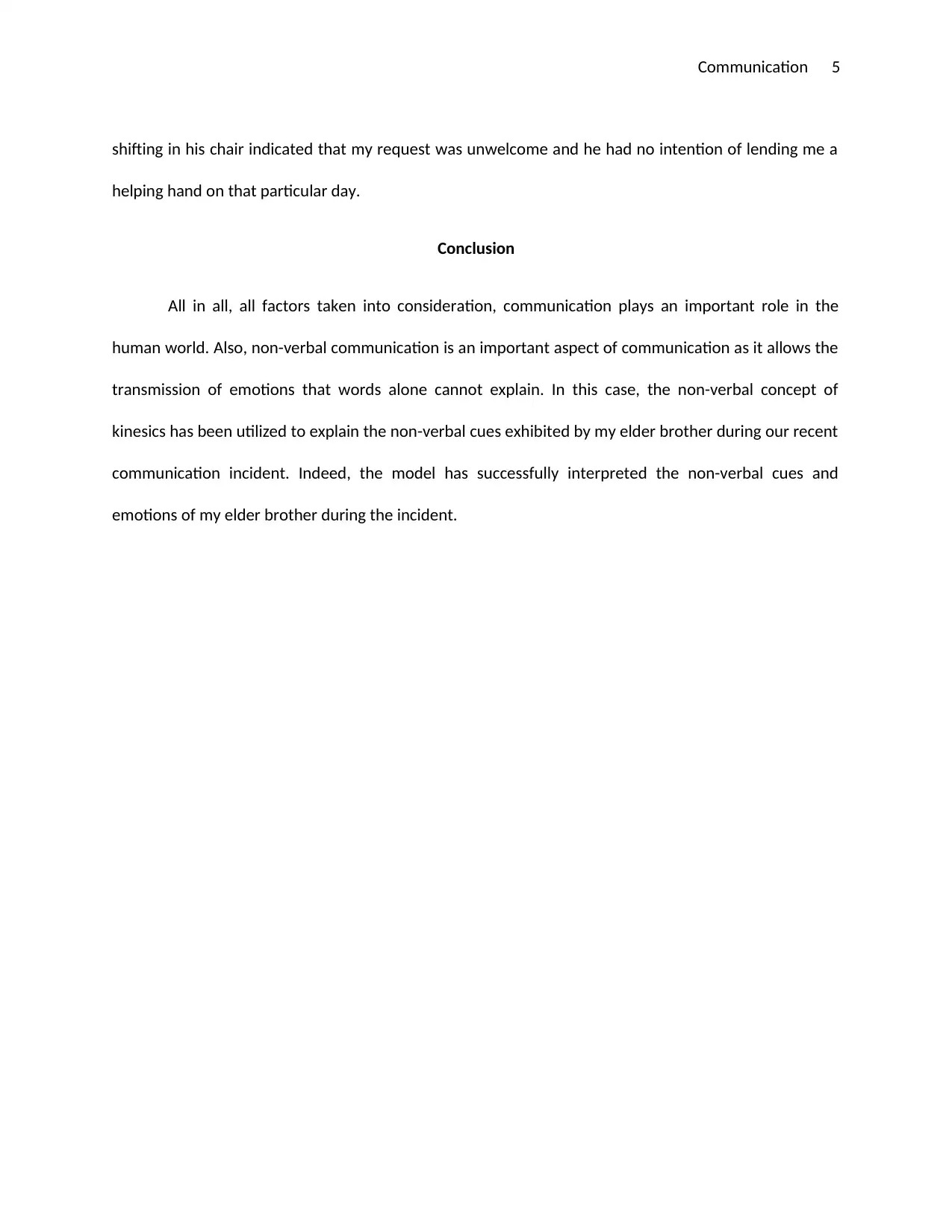
Communication 5
shifting in his chair indicated that my request was unwelcome and he had no intention of lending me a
helping hand on that particular day.
Conclusion
All in all, all factors taken into consideration, communication plays an important role in the
human world. Also, non-verbal communication is an important aspect of communication as it allows the
transmission of emotions that words alone cannot explain. In this case, the non-verbal concept of
kinesics has been utilized to explain the non-verbal cues exhibited by my elder brother during our recent
communication incident. Indeed, the model has successfully interpreted the non-verbal cues and
emotions of my elder brother during the incident.
shifting in his chair indicated that my request was unwelcome and he had no intention of lending me a
helping hand on that particular day.
Conclusion
All in all, all factors taken into consideration, communication plays an important role in the
human world. Also, non-verbal communication is an important aspect of communication as it allows the
transmission of emotions that words alone cannot explain. In this case, the non-verbal concept of
kinesics has been utilized to explain the non-verbal cues exhibited by my elder brother during our recent
communication incident. Indeed, the model has successfully interpreted the non-verbal cues and
emotions of my elder brother during the incident.
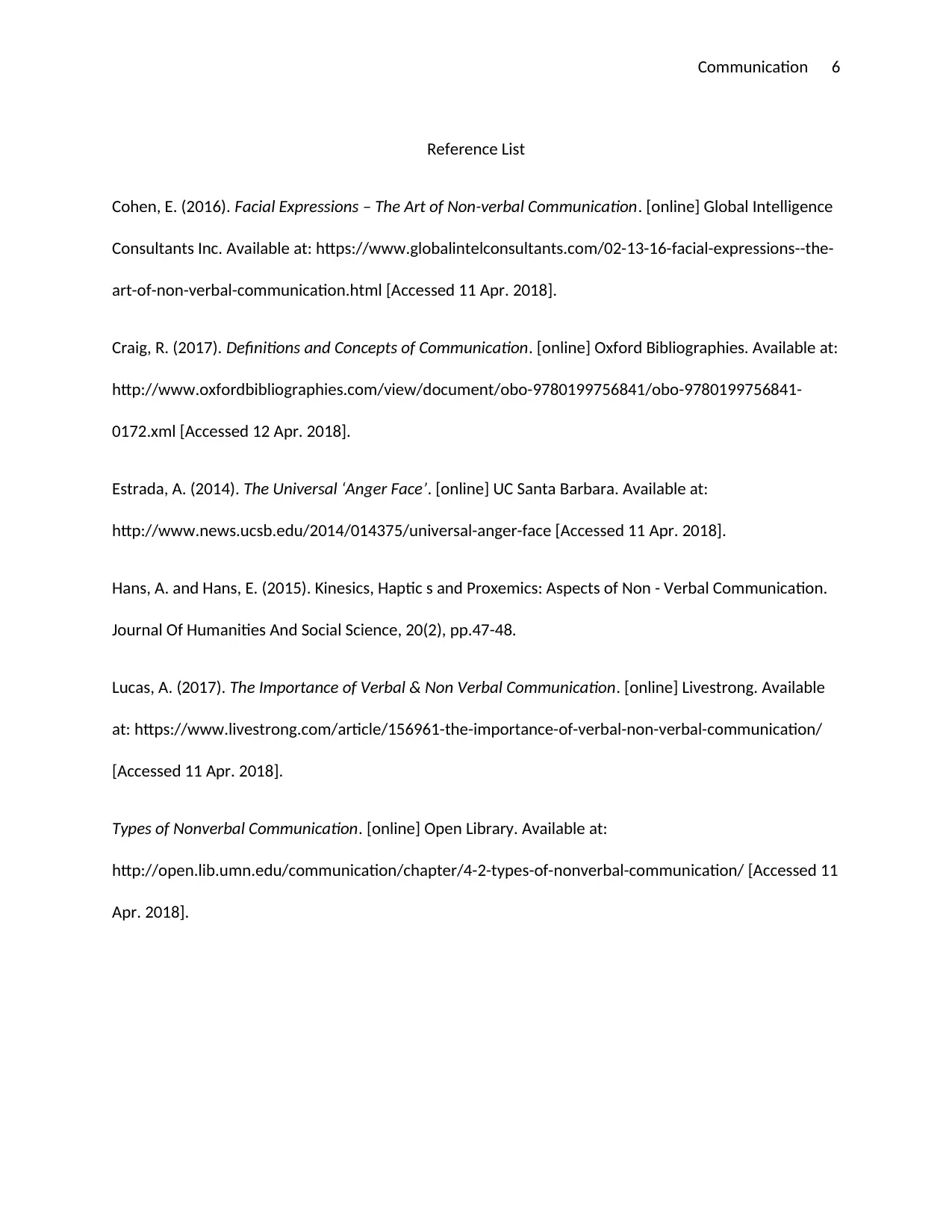
Communication 6
Reference List
Cohen, E. (2016). Facial Expressions – The Art of Non-verbal Communication. [online] Global Intelligence
Consultants Inc. Available at: https://www.globalintelconsultants.com/02-13-16-facial-expressions--the-
art-of-non-verbal-communication.html [Accessed 11 Apr. 2018].
Craig, R. (2017). Definitions and Concepts of Communication. [online] Oxford Bibliographies. Available at:
http://www.oxfordbibliographies.com/view/document/obo-9780199756841/obo-9780199756841-
0172.xml [Accessed 12 Apr. 2018].
Estrada, A. (2014). The Universal ‘Anger Face’. [online] UC Santa Barbara. Available at:
http://www.news.ucsb.edu/2014/014375/universal-anger-face [Accessed 11 Apr. 2018].
Hans, A. and Hans, E. (2015). Kinesics, Haptic s and Proxemics: Aspects of Non - Verbal Communication.
Journal Of Humanities And Social Science, 20(2), pp.47-48.
Lucas, A. (2017). The Importance of Verbal & Non Verbal Communication. [online] Livestrong. Available
at: https://www.livestrong.com/article/156961-the-importance-of-verbal-non-verbal-communication/
[Accessed 11 Apr. 2018].
Types of Nonverbal Communication. [online] Open Library. Available at:
http://open.lib.umn.edu/communication/chapter/4-2-types-of-nonverbal-communication/ [Accessed 11
Apr. 2018].
Reference List
Cohen, E. (2016). Facial Expressions – The Art of Non-verbal Communication. [online] Global Intelligence
Consultants Inc. Available at: https://www.globalintelconsultants.com/02-13-16-facial-expressions--the-
art-of-non-verbal-communication.html [Accessed 11 Apr. 2018].
Craig, R. (2017). Definitions and Concepts of Communication. [online] Oxford Bibliographies. Available at:
http://www.oxfordbibliographies.com/view/document/obo-9780199756841/obo-9780199756841-
0172.xml [Accessed 12 Apr. 2018].
Estrada, A. (2014). The Universal ‘Anger Face’. [online] UC Santa Barbara. Available at:
http://www.news.ucsb.edu/2014/014375/universal-anger-face [Accessed 11 Apr. 2018].
Hans, A. and Hans, E. (2015). Kinesics, Haptic s and Proxemics: Aspects of Non - Verbal Communication.
Journal Of Humanities And Social Science, 20(2), pp.47-48.
Lucas, A. (2017). The Importance of Verbal & Non Verbal Communication. [online] Livestrong. Available
at: https://www.livestrong.com/article/156961-the-importance-of-verbal-non-verbal-communication/
[Accessed 11 Apr. 2018].
Types of Nonverbal Communication. [online] Open Library. Available at:
http://open.lib.umn.edu/communication/chapter/4-2-types-of-nonverbal-communication/ [Accessed 11
Apr. 2018].
⊘ This is a preview!⊘
Do you want full access?
Subscribe today to unlock all pages.

Trusted by 1+ million students worldwide
1 out of 6
Related Documents
Your All-in-One AI-Powered Toolkit for Academic Success.
+13062052269
info@desklib.com
Available 24*7 on WhatsApp / Email
![[object Object]](/_next/static/media/star-bottom.7253800d.svg)
Unlock your academic potential
Copyright © 2020–2025 A2Z Services. All Rights Reserved. Developed and managed by ZUCOL.




